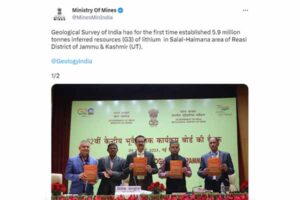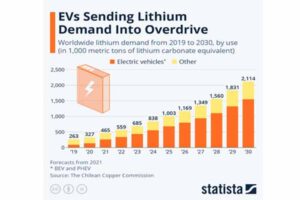The recent discovery of reserves of Lithium in Jammu and Kashmir has invigorated a wave of enthusiasm in the global EV market. Also known as ‘White Gold’ due to its high demand in the global energy market, lithium is used extensively in almost everything in and around us- smartphones, laptops, and digital cameras.
In 1997, the Geological Survey of India (GSI), submitted a report on the presence of lithium reserves in the Reasi district of Jammu, but there was no substantial follow-up after that. 26 years later, on the 9th of February, the Ministry of Mines made a colossal announcement, for the first time major deposits of Lithium had been discovered in India, putting it on the world lithium map and being seen as one of the most lucrative markets in the world.

Analyzing the EV market
If you probe into the costing of an EV, you’ll find that 50% of the production cost goes into batteries. The reason batteries are made of lithium is the virtue of their being extremely lightweight. In just the last year, lithium prices have jumped more than 600%. The world is also overly dependent on China for manufacturing Li-ion cells. 67% of the world’s reserve resides in the Lithium triangle, the combined region around the borders of Bolivia, Argentina, and Chile.
The EV market in India will be worth Rs 475 billion by 2025. Under the scheme of Atmanirbhar Bharat, rigorous exploration and development of manufacturing capacities have been in full swing for the past 5 years. Also, most of the ministers unanimously now agree that the dinosaur mindset of holding onto oil would be ludicrous. The government currently intends to reduce oil import bills, last year we paid around 119 billion dollars for oil imports. To accomplish fiscal independence and be the flagbearer of the clean energy revolution, the discovery of lithium reserves is a huge step ahead. Currently almost 100% of the lithium that we use, we import. It’ll also result in better employment opportunities and give the ministry leverage in geopolitical discussions.
The Government impetus
The Faster Adoption and Manufacturing of Electric Vehicles (FAME) scheme was launched in 2015 under the National Electric Mobility Mission, to finance infrastructure and incentivize people to adopt electric vehicles. The first phase lasted till 2019. The second phase (FAME II) is a 3-year subsidy program with an expenditure of 10,000 crores. It aims at supporting the electrification of public and shared transportation. There is also a PLI (production-linked incentive) scheme for Advanced Chemistry Cell (ACC) of 18,100 crores, for the automotive sector of 25,938 crores,s and for Faster Adoption of Manufacturing of Electric Vehicles (FAME) of 10,000 crores.
By 2030, the government is targeting 30% of private cars to be electric, currently, it is 0.5%. And 70% of commercial vehicles and 80% of two and three-wheelers to be electric. There would
also, be an upsurge of E-mobility service providers (EMSP) which provide access to multiple charging stations to their customers.
The most expensive thing people buy in their lives is a house, the second is usually automobiles. Being such a big ticket size purchase there should be not even an iota of doubt within their minds; the before, during, and after purchase, experiences should be smooth and convenient.
An intricate nationwide network of charging infrastructure is essential to give the common man the confidence of buying an EV. At the end of 2022, India had 2700 charging stations, it aims to install 10,00 by 2025. It is estimated we would require upwards of 20 lakh stations to be in sync with the EV demand. India is now being seen as a potential dethroner of China’s manufacturing monopoly in lithium batteries. If we seize hold of this opportunity, India would be a force to reckon with in the coming years.







